Chengyang Li
C-DGPA: Class-Centric Dual-Alignment Generative Prompt Adaptation
Dec 18, 2025Abstract:Unsupervised Domain Adaptation transfers knowledge from a labeled source domain to an unlabeled target domain. Directly deploying Vision-Language Models (VLMs) with prompt tuning in downstream UDA tasks faces the signifi cant challenge of mitigating domain discrepancies. Existing prompt-tuning strategies primarily align marginal distribu tion, but neglect conditional distribution discrepancies, lead ing to critical issues such as class prototype misalignment and degraded semantic discriminability. To address these lim itations, the work proposes C-DGPA: Class-Centric Dual Alignment Generative Prompt Adaptation. C-DGPA syner gistically optimizes marginal distribution alignment and con ditional distribution alignment through a novel dual-branch architecture. The marginal distribution alignment branch em ploys a dynamic adversarial training framework to bridge marginal distribution discrepancies. Simultaneously, the con ditional distribution alignment branch introduces a Class Mapping Mechanism (CMM) to align conditional distribu tion discrepancies by standardizing semantic prompt under standing and preventing source domain over-reliance. This dual alignment strategy effectively integrates domain knowl edge into prompt learning via synergistic optimization, ensur ing domain-invariant and semantically discriminative repre sentations. Extensive experiments on OfficeHome, Office31, and VisDA-2017 validate the superiority of C-DGPA. It achieves new state-of-the-art results on all benchmarks.
Myocardial Region-guided Feature Aggregation Net for Automatic Coronary artery Segmentation and Stenosis Assessment using Coronary Computed Tomography Angiography
Apr 27, 2025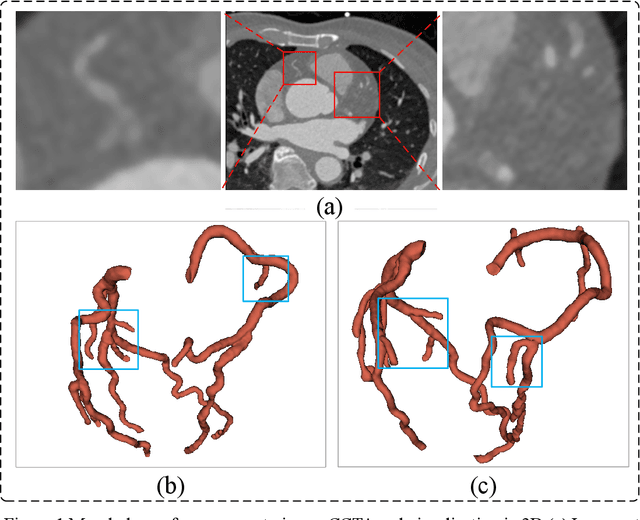
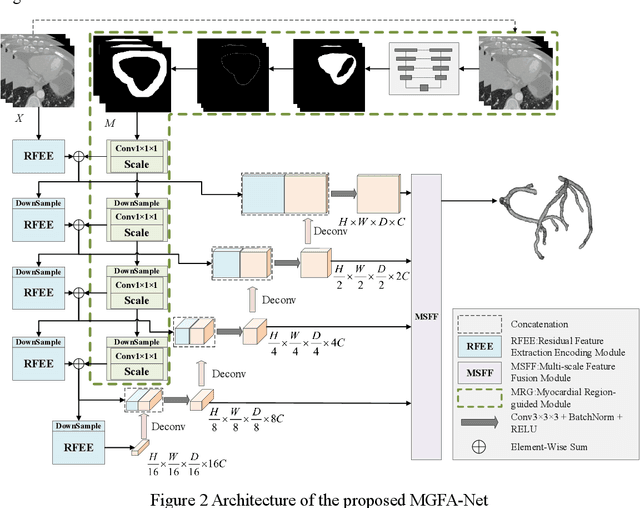
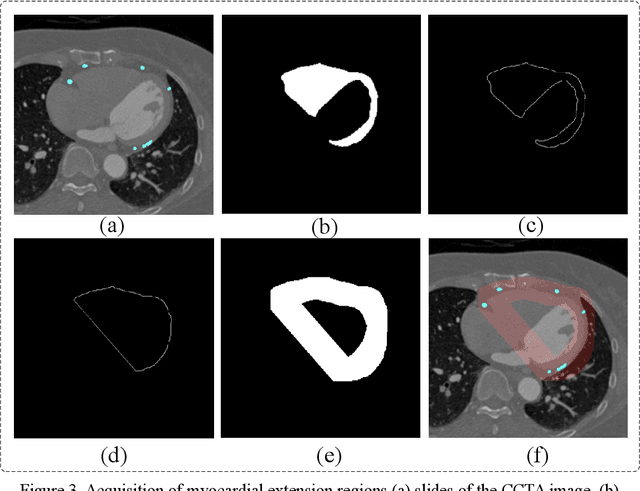
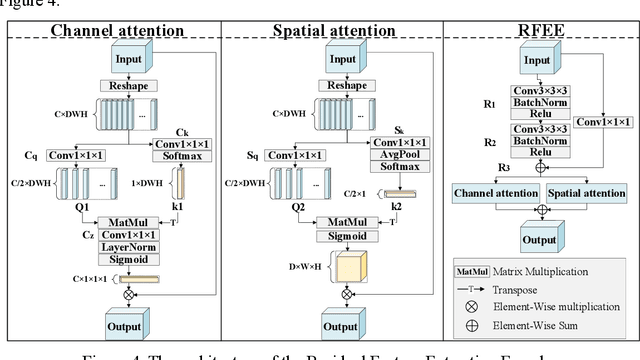
Abstract:Coronary artery disease (CAD) remains a leading cause of mortality worldwide, requiring accurate segmentation and stenosis detection using Coronary Computed Tomography angiography (CCTA). Existing methods struggle with challenges such as low contrast, morphological variability and small vessel segmentation. To address these limitations, we propose the Myocardial Region-guided Feature Aggregation Net, a novel U-shaped dual-encoder architecture that integrates anatomical prior knowledge to enhance robustness in coronary artery segmentation. Our framework incorporates three key innovations: (1) a Myocardial Region-guided Module that directs attention to coronary regions via myocardial contour expansion and multi-scale feature fusion, (2) a Residual Feature Extraction Encoding Module that combines parallel spatial channel attention with residual blocks to enhance local-global feature discrimination, and (3) a Multi-scale Feature Fusion Module for adaptive aggregation of hierarchical vascular features. Additionally, Monte Carlo dropout f quantifies prediction uncertainty, supporting clinical interpretability. For stenosis detection, a morphology-based centerline extraction algorithm separates the vascular tree into anatomical branches, enabling cross-sectional area quantification and stenosis grading. The superiority of MGFA-Net was demonstrated by achieving an Dice score of 85.04%, an accuracy of 84.24%, an HD95 of 6.1294 mm, and an improvement of 5.46% in true positive rate for stenosis detection compared to3D U-Net. The integrated segmentation-to-stenosis pipeline provides automated, clinically interpretable CAD assessment, bridging deep learning with anatomical prior knowledge for precision medicine. Our code is publicly available at http://github.com/chenzhao2023/MGFA_CCTA
SMGDiff: Soccer Motion Generation using diffusion probabilistic models
Nov 25, 2024


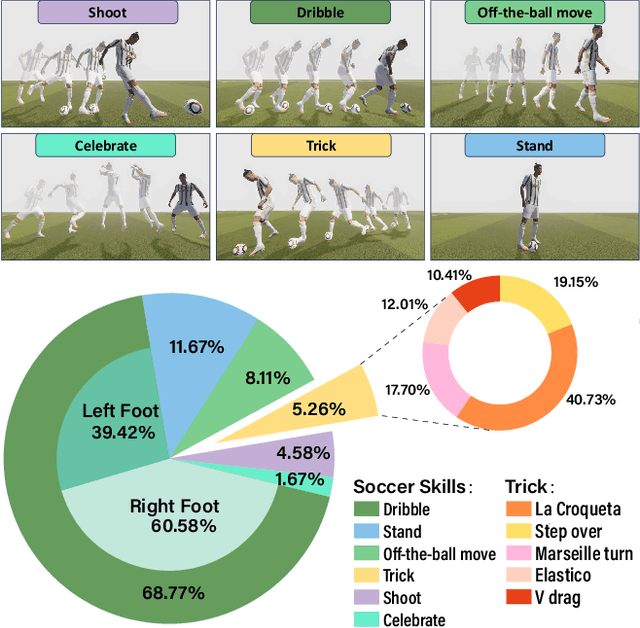
Abstract:Soccer is a globally renowned sport with significant applications in video games and VR/AR. However, generating realistic soccer motions remains challenging due to the intricate interactions between the human player and the ball. In this paper, we introduce SMGDiff, a novel two-stage framework for generating real-time and user-controllable soccer motions. Our key idea is to integrate real-time character control with a powerful diffusion-based generative model, ensuring high-quality and diverse output motion. In the first stage, we instantly transform coarse user controls into diverse global trajectories of the character. In the second stage, we employ a transformer-based autoregressive diffusion model to generate soccer motions based on trajectory conditioning. We further incorporate a contact guidance module during inference to optimize the contact details for realistic ball-foot interactions. Moreover, we contribute a large-scale soccer motion dataset consisting of over 1.08 million frames of diverse soccer motions. Extensive experiments demonstrate that our SMGDiff significantly outperforms existing methods in terms of motion quality and condition alignment.
Multi-scale Frequency Enhancement Network for Blind Image Deblurring
Nov 11, 2024Abstract:Image deblurring is an essential image preprocessing technique, aiming to recover clear and detailed images form blurry ones. However, existing algorithms often fail to effectively integrate multi-scale feature extraction with frequency enhancement, limiting their ability to reconstruct fine textures. Additionally, non-uniform blur in images also restricts the effectiveness of image restoration. To address these issues, we propose a multi-scale frequency enhancement network (MFENet) for blind image deblurring. To capture the multi-scale spatial and channel information of blurred images, we introduce a multi-scale feature extraction module (MS-FE) based on depthwise separable convolutions, which provides rich target features for deblurring. We propose a frequency enhanced blur perception module (FEBP) that employs wavelet transforms to extract high-frequency details and utilizes multi-strip pooling to perceive non-uniform blur, combining multi-scale information with frequency enhancement to improve the restoration of image texture details. Experimental results on the GoPro and HIDE datasets demonstrate that the proposed method achieves superior deblurring performance in both visual quality and objective evaluation metrics. Furthermore, in downstream object detection tasks, the proposed blind image deblurring algorithm significantly improves detection accuracy, further validating its effectiveness androbustness in the field of image deblurring.
Autonomous Driving in Unstructured Environments: How Far Have We Come?
Oct 10, 2024
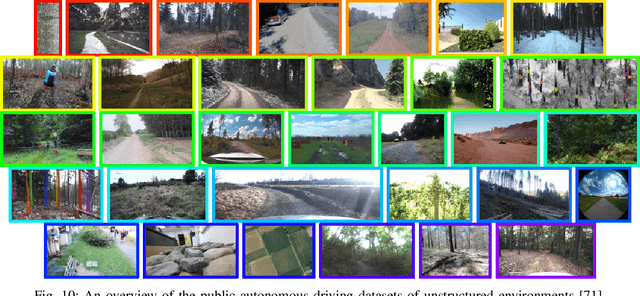
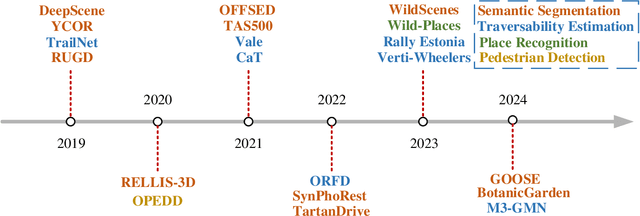
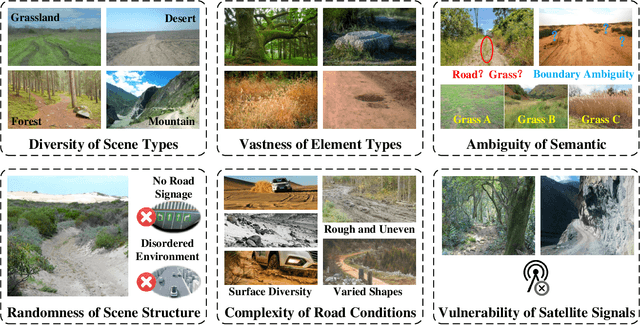
Abstract:Research on autonomous driving in unstructured outdoor environments is less advanced than in structured urban settings due to challenges like environmental diversities and scene complexity. These environments-such as rural areas and rugged terrains-pose unique obstacles that are not common in structured urban areas. Despite these difficulties, autonomous driving in unstructured outdoor environments is crucial for applications in agriculture, mining, and military operations. Our survey reviews over 250 papers for autonomous driving in unstructured outdoor environments, covering offline mapping, pose estimation, environmental perception, path planning, end-to-end autonomous driving, datasets, and relevant challenges. We also discuss emerging trends and future research directions. This review aims to consolidate knowledge and encourage further research for autonomous driving in unstructured environments. To support ongoing work, we maintain an active repository with up-to-date literature and open-source projects at: https://github.com/chaytonmin/Survey-Autonomous-Driving-in-Unstructured-Environments.
Learn2Talk: 3D Talking Face Learns from 2D Talking Face
Apr 19, 2024



Abstract:Speech-driven facial animation methods usually contain two main classes, 3D and 2D talking face, both of which attract considerable research attention in recent years. However, to the best of our knowledge, the research on 3D talking face does not go deeper as 2D talking face, in the aspect of lip-synchronization (lip-sync) and speech perception. To mind the gap between the two sub-fields, we propose a learning framework named Learn2Talk, which can construct a better 3D talking face network by exploiting two expertise points from the field of 2D talking face. Firstly, inspired by the audio-video sync network, a 3D sync-lip expert model is devised for the pursuit of lip-sync between audio and 3D facial motion. Secondly, a teacher model selected from 2D talking face methods is used to guide the training of the audio-to-3D motions regression network to yield more 3D vertex accuracy. Extensive experiments show the advantages of the proposed framework in terms of lip-sync, vertex accuracy and speech perception, compared with state-of-the-arts. Finally, we show two applications of the proposed framework: audio-visual speech recognition and speech-driven 3D Gaussian Splatting based avatar animation.
OmniColor: A Global Camera Pose Optimization Approach of LiDAR-360Camera Fusion for Colorizing Point Clouds
Apr 06, 2024



Abstract:A Colored point cloud, as a simple and efficient 3D representation, has many advantages in various fields, including robotic navigation and scene reconstruction. This representation is now commonly used in 3D reconstruction tasks relying on cameras and LiDARs. However, fusing data from these two types of sensors is poorly performed in many existing frameworks, leading to unsatisfactory mapping results, mainly due to inaccurate camera poses. This paper presents OmniColor, a novel and efficient algorithm to colorize point clouds using an independent 360-degree camera. Given a LiDAR-based point cloud and a sequence of panorama images with initial coarse camera poses, our objective is to jointly optimize the poses of all frames for mapping images onto geometric reconstructions. Our pipeline works in an off-the-shelf manner that does not require any feature extraction or matching process. Instead, we find optimal poses by directly maximizing the photometric consistency of LiDAR maps. In experiments, we show that our method can overcome the severe visual distortion of omnidirectional images and greatly benefit from the wide field of view (FOV) of 360-degree cameras to reconstruct various scenarios with accuracy and stability. The code will be released at https://github.com/liubonan123/OmniColor/.
NeuPAN: Direct Point Robot Navigation with End-to-End Model-based Learning
Mar 11, 2024

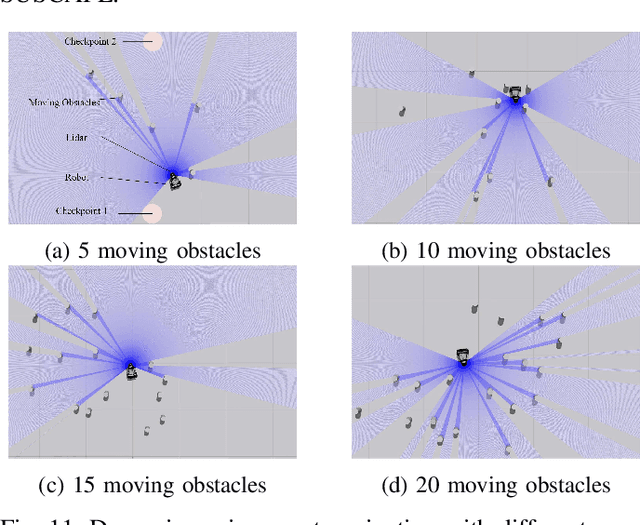
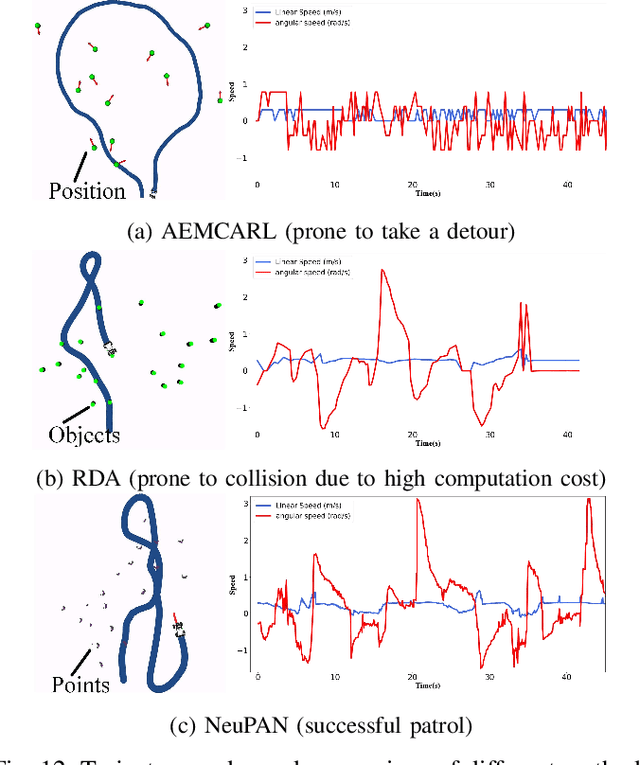
Abstract:Navigating a nonholonomic robot in a cluttered environment requires extremely accurate perception and locomotion for collision avoidance. This paper presents NeuPAN: a real-time, highly-accurate, map-free, robot-agnostic, and environment-invariant robot navigation solution. Leveraging a tightly-coupled perception-locomotion framework, NeuPAN has two key innovations compared to existing approaches: 1) it directly maps raw points to a learned multi-frame distance space, avoiding error propagation from perception to control; 2) it is interpretable from an end-to-end model-based learning perspective, enabling provable convergence. The crux of NeuPAN is to solve a high-dimensional end-to-end mathematical model with various point-level constraints using the plug-and-play (PnP) proximal alternating-minimization network (PAN) with neurons in the loop. This allows NeuPAN to generate real-time, end-to-end, physically-interpretable motions directly from point clouds, which seamlessly integrates data- and knowledge-engines, where its network parameters are adjusted via back propagation. We evaluate NeuPAN on car-like robot, wheel-legged robot, and passenger autonomous vehicle, in both simulated and real-world environments. Experiments demonstrate that NeuPAN outperforms various benchmarks, in terms of accuracy, efficiency, robustness, and generalization capability across various environments, including the cluttered sandbox, office, corridor, and parking lot. We show that NeuPAN works well in unstructured environments with arbitrary-shape undetectable objects, making impassable ways passable.
Application of Deep Learning in Blind Motion Deblurring: Current Status and Future Prospects
Jan 10, 2024Abstract:Motion deblurring is one of the fundamental problems of computer vision and has received continuous attention. The variability in blur, both within and across images, imposes limitations on non-blind deblurring techniques that rely on estimating the blur kernel. As a response, blind motion deblurring has emerged, aiming to restore clear and detailed images without prior knowledge of the blur type, fueled by the advancements in deep learning methodologies. Despite strides in this field, a comprehensive synthesis of recent progress in deep learning-based blind motion deblurring is notably absent. This paper fills that gap by providing an exhaustive overview of the role of deep learning in blind motion deblurring, encompassing datasets, evaluation metrics, and methods developed over the last six years. Specifically, we first introduce the types of motion blur and the fundamental principles of deblurring. Next, we outline the shortcomings of traditional non-blind deblurring algorithms, emphasizing the advantages of employing deep learning techniques for deblurring tasks. Following this, we categorize and summarize existing blind motion deblurring methods based on different backbone networks, including convolutional neural networks, generative adversarial networks, recurrent neural networks, and Transformer networks. Subsequently, we elaborate not only on the fundamental principles of these different categories but also provide a comprehensive summary and comparison of their advantages and limitations. Qualitative and quantitative experimental results conducted on four widely used datasets further compare the performance of SOTA methods. Finally, an analysis of present challenges and future pathways. All collected models, benchmark datasets, source code links, and codes for evaluation have been made publicly available at https://github.com/VisionVerse/Blind-Motion-Deblurring-Survey
You Do Not Need Additional Priors in Camouflage Object Detection
Oct 01, 2023Abstract:Camouflage object detection (COD) poses a significant challenge due to the high resemblance between camouflaged objects and their surroundings. Although current deep learning methods have made significant progress in detecting camouflaged objects, many of them heavily rely on additional prior information. However, acquiring such additional prior information is both expensive and impractical in real-world scenarios. Therefore, there is a need to develop a network for camouflage object detection that does not depend on additional priors. In this paper, we propose a novel adaptive feature aggregation method that effectively combines multi-layer feature information to generate guidance information. In contrast to previous approaches that rely on edge or ranking priors, our method directly leverages information extracted from image features to guide model training. Through extensive experimental results, we demonstrate that our proposed method achieves comparable or superior performance when compared to state-of-the-art approaches.
 Add to Chrome
Add to Chrome Add to Firefox
Add to Firefox Add to Edge
Add to Edge